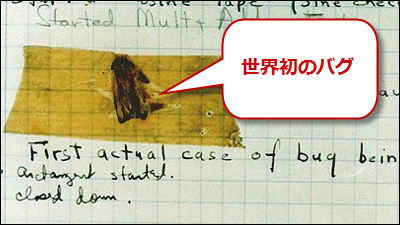'Loops', 'patches', 'libraries', 'bugs' etc. are derived from the legendary system 'Harvard Mark I'

Repeating a specific process in a program is called a 'loop', and a patch is called a 'patch'. These terms are derived from 'Harvard Mark I' developed in 1944.
Harvard IBM Mark I-Language | The Collection of Historical Scientific Instruments
https://chsi.harvard.edu/harvard-ibm-mark-1-language
The digital computer was created at the time when it coincided with World War II. Howard Aiken, a graduate of the University of Wisconsin-Madison with a PhD in physics, was enrolled at Harvard University in 1939, when he encountered a differential equation that only he could solve. The idea is 'electromechanical computing device'.
The device made in collaboration with IBM was originally called 'ASCC (Automated Sequence Control Calculator)', but later became known as 'Harvard Mark I'. I did.
◆ Loop
The recording medium used in the arithmetic unit at that time was paper tape (perforated tape), and Mark I also read commands from the tape and executed them. When repeating the instruction, it was necessary to read the contents of the same tape many times, but if it is left as it is, it will be necessary to read the read tape again by yourself.
What was done there was a method of sticking the start and end points of the tape together to form a loop and continuing to read. From here on, repeating is now referred to as a 'loop.'
The Harvard Museum of Science and History has a photo of Mark I with a ring of tape.

◆ Patch
Software patches are called 'patches.' A patch is a 'patch cloth', which is derived from the fact that when the recording medium was paper tape as mentioned above, the 'patch' was really applied to the part that needed to be corrected.
Why are software patches called 'patches'? --GIGAZINE

◆ Library
In the IT terminology dictionary e-words, it is defined as 'a computer program with a specific function is called into parts so that it can be used by calling it from another program, and multiple such program parts are collected and stored in one file.' The 'library' that has been.
This is also due to the fact that only the necessary parts of the program recorded on the tape were cut and put together so that they could be reused at any time later. It looks completely different from a 'library', but its function may be like a library.

In Japanese animation, special moves and transformation scenes where the same thing appears over and over, or familiar landscapes and scenes are called 'banks' (bank scenes) that use the same material over and over again. increase. This is a name that is likened to a bank because it saves (stores) the scene and retrieves it where needed, but considering its origin, it may have been a 'library'.
◆ Bug
Bugs hidden in computer programs are called 'bugs', but it is a well-known story that the world's first computer bug was really caused by a moth. This 'computer with moths' was not Mark I but Mark II, which appeared in 1947.
The world's first computer bug is really caused by a 'moth' being caught-GIGAZINE

In fact, even before the moths were caught, electricians called 'bug' a hard-to-find physical defect that hindered the operation of electrical equipment. While coding Mark I, the technician encountered a bug, and a 'bug picture' by Grace Hopper , known for finding the 'moth,' is left at the Smithsonian Archive Center.

Related Posts:
in Hardware, Posted by logc_nt





